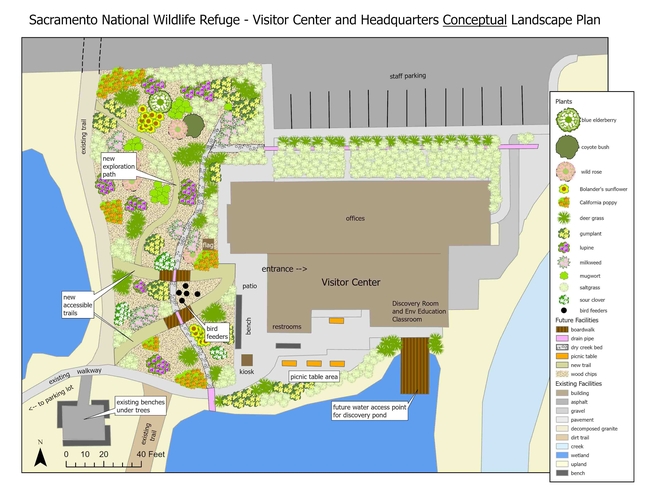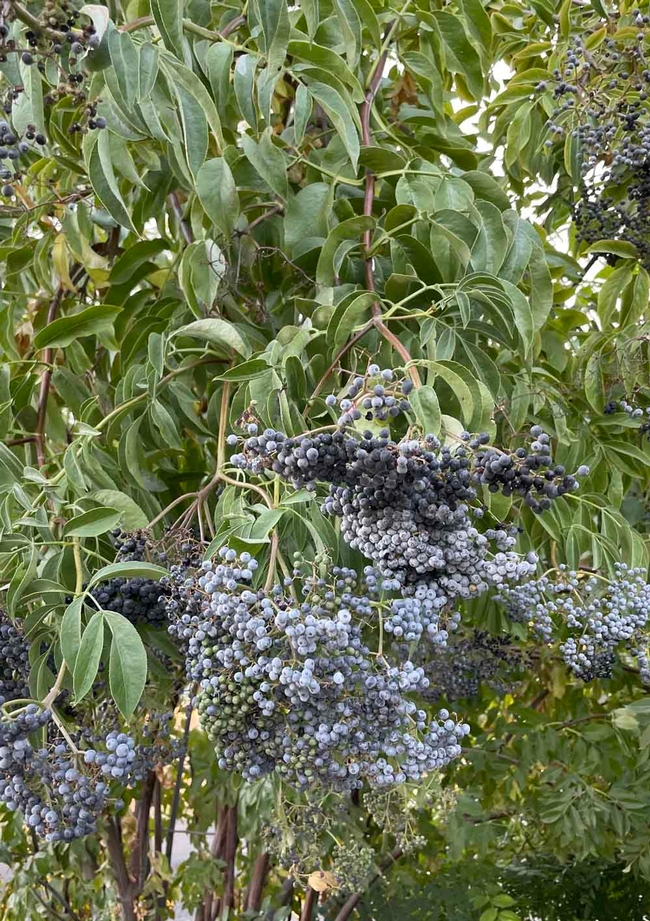The Sacramento National Wildlife Refuge in Willows is headquarters to the Sacramento National Wildlife Complex. In January of this year, construction was completed on a beautiful new headquarters building and Visitor Center for the Complex. As part of this project, the Refuge is working on plans to establish a native plant garden around the new building. Funding will come from grants and donations arranged by Refuge partners, including Altacal Audubon and Friends of the Sacramento National Wildlife Refuge.
On May 30th, 2024 Jared Geiser, Executive Director of AltaCal Audubon and Deborah Halfpenny, Neighborhood Habitat Certification Program Planner for AltaCal Audubon met with Refuge Project Leader Sharon Vaughn, Biologist Jennifer Isolaand Park Ranger Nikki Muench to discuss garden planning and potential volunteerism to help in the development and maintenance of the garden.
The Refuge has developed an inviting landscape plan that includes accessible trails, a dry creek bed for drainage, picnic tables, and feeders to bring birds up close for viewing. The garden will feature plants such as California Wild Rose, Coyote Bush, Bolander's Sunflower, California Poppy and Salt Grass. These native plants are adapted to the valley climate and alkaline clay soil of the refuge, and will provide habitat for birds such as finches, warblers, sparrows, towhees and kinglets as well as pollinators like Monarch butterflies and native bees.
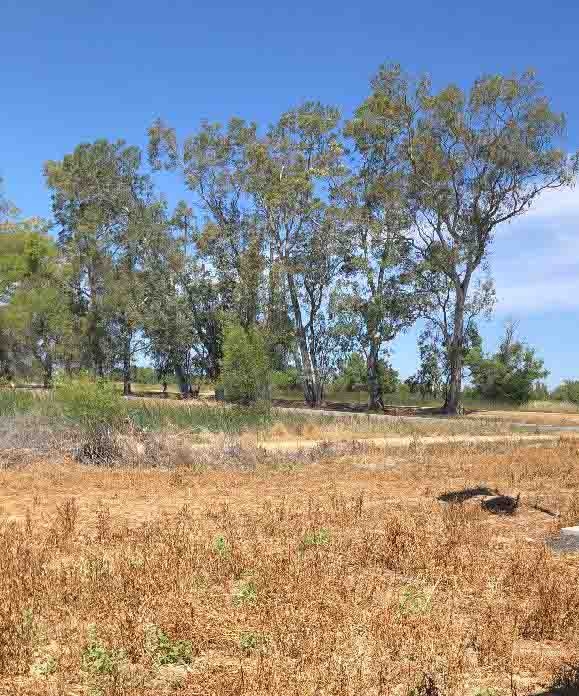
Over the course of the next year, garden soil will be prepared to improve topography, establish drainage, and control invasive weeds. Planting is planned for the fall of 2025.
The deep overhanging roof at the front of the Visitor Center will provide a comfortable area for garden and wildlife viewing, and for hosting educational programs for students of all ages. Throughout the coming year, work will be completed on new displays and kiosks, the native plant garden, and a demonstration pond.
The Sacramento National Wildlife Refuge is open seven days a week, from one hour before sunrise until one hour after sunset. The new Visitor Center is open Thursdays and Fridays from 9:00am to 4:00pm (subject to change, and closed on all federal holidays).
The Refuge is hopeful that with the help of partners and volunteers this garden will prove to be a vibrant focal point for their visitors: humans, birds and insects! If you are interested in becoming part of this exciting project, you can contact the Refuge volunteer program, Friends of the Sacramento National Wildlife Refuge or Altacal Audubon. See details below.
The Sacramento National Wildlife Complex
Sacramento National Wildlife Refuge (Sacramento NWR) is one of the five National Wildlife Refuges and three Wildlife Management Areas that make up the Sacramento National Wildlife Refuge Complex. The others are the Delevan National Wildlife Refuge (Delevan NWR); the Colusa National Wildlife Refuge (Colusa NWR); The Sutter National Wildlife Refuge (Sutter NWR); the Sacramento River National Wildlife Refuge (Sacramento River NWR); the Llano Seco Unit (Llano Seco Unit (STNCV WMA)); the Butte Sink Wildlife Management Area (Butte Sink WMA); and the Willow Creek-Lurline Wildlife Management Area.( Willow Creek-Lurline WMA).
Across the Complex there are many opportunities for recreation including trails, bicycling, photography, hunting, auto tours (at Sacramento NWR and Colusa NWR) and environmental education.
The Complex welcomes volunteers in a variety of areas on all of its Refuges and Management Areas. Individual volunteers must be at least 16 years old. For more information on volunteering, contact Visitor Services staff at sacramentovalleyrefuges@fws.gov or call (530) 934-2801.
Friends of the Sacramento National Wildlife Refuge
This support group was formed in early 2020 by a group of individuals passionate about the Sacramento National Wildlife Refuge Complex. Recognizing the importance of the Complex to the region and the ongoing need for additional resources, their mission is to work in partnership with the Complex and the public to maintain the Refuges and Wildlife Areas of the Complex, broaden wildlife observation and education, and expand recreational opportunities, bringing these resources to a broader audience in the Central Valley.
Find out more about how you can help on their website, or check out their Facebook and Instagram pages.
The AltaCal Audobon Society
AltaCal Audobon serves Butte, Glenn, and Tehama Counties and, as noted on their website, is “dedicated to preserving and protecting birds and their habitats through education, monthly programs on birds and related topics, field trips to natural areas and wildlife refuges, outreach booths at local events, and youth outdoor education activities.”
AltaCal Audubon is fortunate to be located along the Pacific Flyway, a major migratory route for many birds, and centered in one of the most diversified wildlife regions in California. This unique area is rich with exemplary bird habitat, hosting abundant wintering waterfowl, native raptors, and varied terrestrial wildlife. Contact them at: www.altacal.org and director@altacal.org for further information.
UC Master Gardeners of Butte County are part of the University of California Cooperative Extension (UCCE) system. To learn more about us and our upcoming events, and for help with gardening in our area visit our website. If you have a gardening question or problem, email the Hotline at mgbutte@ucanr.edu or leave a phone message on our Hotline at 530-552-5812. To speak to a Master Gardener about a gardening issue, or to drop by the MG office during Hotline hours, see the most current information on our Ask Us section of our website.
Gardeners looking for a drought-tolerant and highly disease-resistant native shrub might consider adding the blue elderberry (Sambucus cerulean also known as Sambucus Mexicana) to their landscape. This species of elderberry is native to the West coast of North America at elevations ranging from sea level to 10,000 feet from Baja to British Columbia. Although it is drought tolerant, it can be considered riparian because it prefers moist locations near rivers or springs. It will also show itself to be particularly thankful for fertile, nitrogen-rich soils.
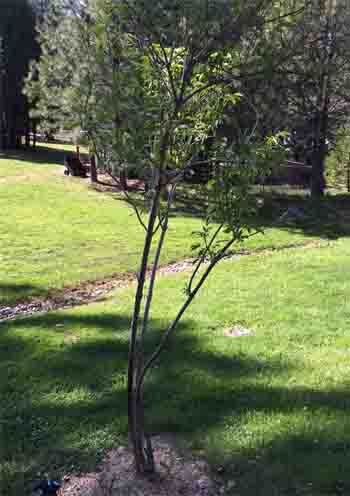
The elderberry can be identified through its flowers in late spring, and bunches of blueish berries in mid to late-summer. Typically, hundreds of tiny flowers comprise what appears to be one light cream-colored flower in skyward-facing bunches. A waxy coating on the purple berries gives them their blueish finish. Another distinctive characteristic is that the elderberry is among the first shrubs to show green shoots, sometimes in late fall after the first rains and even well before the California buckeye, another early blooming native.
The plant's flowers and berries are valuable for native wildlife. Nearly two dozen moths and butterflies seek the pollen from the fragrant cream-colored elderberry flower. The berries are an important source of food for native birds in California. Once birds eat the berries, they return the favor by helping the plant propagate, spreading the un-digested seeds far and wide.
According to UC Cooperative Extension advisor Rachael Long, the elderberry is one of several natives that provide nectar and pollen for native bees, honey bees, and other insects. “I see a lot of green lace wings (predators of aphids, spider mites and other pests) in elderberry” she notes. The berries are edible for humans if properly prepared. They contain a mild toxin which can easily be cooked out.
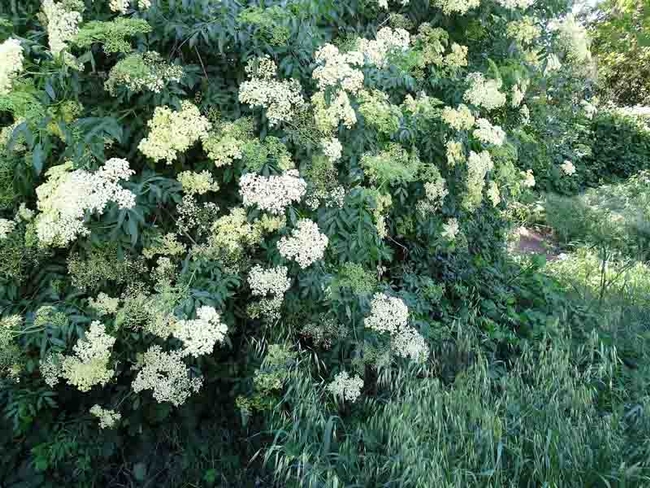
The elderberry gets its name from Anglo-Saxon words: “auld” or “ellarn”, meaning fire or kindle, because the hollow branches were used to direct air blown into kindling. Those hollow stems also led to their use as musical instruments, among these the "Sambuke" from which the genus name "Sambucus" was derived.
Elderberry references make cultural appearances spanning space and time. In Greek mythology, the Titan Prometheus presented the gift of fire to man in a hollow elderberry branch. In our own time, it is the elder wand, fashioned in part from elderberry wood, which delivers a decisive blow for good over evil in the final chapter of J.K. Rowling's Harry Potter series.
Blue elderberry grows extensively throughout Butte County, favoring streamside locations. For example, in Chico it can easily be found along Big and Little Chico Creeks and Lindo channel. In places along these waterways, there are nearly unbroken stretches of elderberry thickets. The elderberry's tenacity can be seen in the burn-scar area of Butte Creek canyon, where vigorous elderberry canes are re-emerging in profusion.
Blue Elderberry is the only host plant of the Valley Elderberry Longhorn Beetle (Desmocerus californicus dimorphus), a Federally Threatened species. This beetle's current California Fish & Wildlife Service status is “threatened” due to loss of habitat resulting from conversion of land to agriculture, grazing, and levee construction; competition from non-native species; and loss of land to development for recreational, industrial and urban purposes. The adult beetles eat elderberry leaves and flowers, and the larvae eat the pithy inside of the elderberry stem, where they live for part of their lives. Because of the “threatened” status of the beetle, and the fact that the blue elderberry shrub is its host plant (its habitat, so to speak), the elderberry shrub is protected from being disturbed, destroyed, removed, and even trimmed, if the branches are larger than 1 inch in diameter, since the beetle larvae could potentially be living inside branches of that size or larger. In your yard, the elderberry can be managed by pruning as long as the branches are smaller than 1 inch in diameter. Small elderberry branches are hollow and pithy and fairly easy to cut.
If you have space in your yard for a hardy native shrub that will provide food for beneficial insects and pollinators, consider the elderberry. It's best to enjoy this multi-use shrub in a section of your yard where it will not be disturbed, and where it can grow to its full size (30 feet) without needing to be trimmed or moved.
UC Master Gardeners of Butte County are part of the University of California Cooperative Extension (UCCE) system. To learn more about us and our upcoming events, and for help with gardening in our area visit our website. If you have a gardening question or problem, email the Hotline at mgbutte@ucanr.edu or leave a phone message on our Hotline at 530-552-5812. To speak to a Master Gardener about a gardening issue, or to drop by the MG office during Hotline hours, see the most current information on our Ask Us section of our website.
Chilopsis linearis, the desert willow or desert catalpa, is prized in dry gardens for its showy, fragrant blossoms which cover the tree in summer. When many native bloomers are past their spring glory and entering semi-dormancy to protect against heat and drought, the desert willow is just getting started; this tree loves the long hot days of summer. It does best in full sun, becoming leggy and thin in part shade. It is extremely drought resistant and will succumb to root rot if not planted in a well- drained, seldom-irrigated location. In the wild, it will grow in certain riparian conditions, particularly in desert regions along streams, washes, and channels that are ephemeral, drying up between rains. Deciduous in winter, desert willows may shed some leaves in extreme summers to help conserve energy and food.
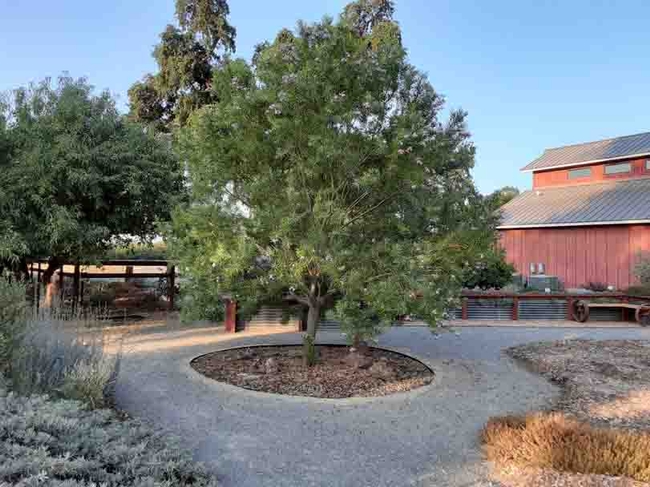
Although the tree normally doesn't grow taller than 25 feet, the registry of Big Trees has recorded a specimen in Porterville that is 40 feet tall, with a canopy spread of 36 feet and a trunk circumference of just over six feet. That's pretty big for a tree billed by multiple sources as a “small accent tree” for native landscaping.
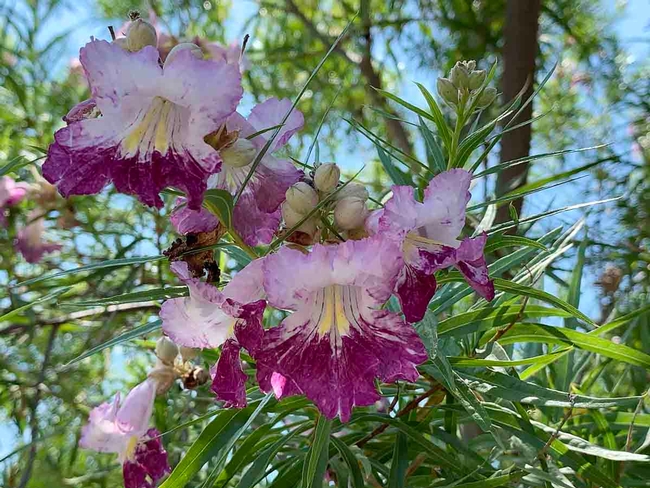
There are many common names for this lovely tree: flowering willow, desert catalpa, willow-leaved catalpa, willowleaf catalpa, bow willow, flor de mimbre, and mimbre. Mimbre is a Spanish word that is sometimes translated as willow or wicker, but technically means the twigs and sprigs of willow trees that were woven into baskets or furniture.
The desert willow is native to the Southwestern U.S. and Northern Mexico; its native range in California is restricted to the arid southern portions of our state, primarily San Bernardino and Riverside counties. The US Department of Agriculture notes that it can occur naturally as far east as southwest Kansas and eastern Oklahoma. Anywhere that's hot, sunny, dry, and not above 5,000 feet in elevation will support this hardy tree with a life span of between 40 and 150 years.
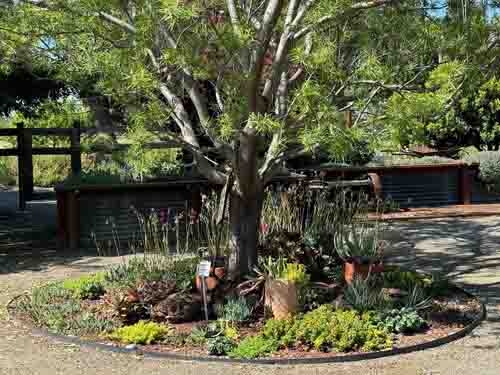
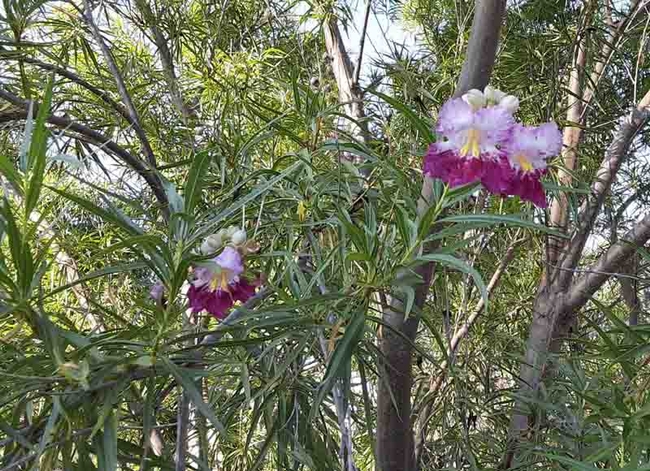
UC Master Gardeners of Butte County are part of the University of California Cooperative Extension (UCCE) system. To learn more about us and our upcoming events, and for help with gardening in our area visit our website. If you have a gardening question or problem, email the Hotline at mgbutte@ucanr.edu or leave a phone message on our Hotline at 530-552-5812. To speak to a Master Gardener about a gardening issue, or to drop by the MG office during Hotline hours, see the most current information on our Ask Us section of our website.
Redbuds in bloom are a most welcome harbinger of spring. Their dense clusters of magenta flowers bloom early, providing splashes of color against a winter landscape of browns and grays. Is the name redbud really the best our ancestors could come up with for this beautiful tree? How could they call that color “red”? Even Wikipedia manages a more accurate “pink to purple.” Other sources are more specific, identifying the brilliant flora as bright pink, rosy pink, magenta, or reddish purple.
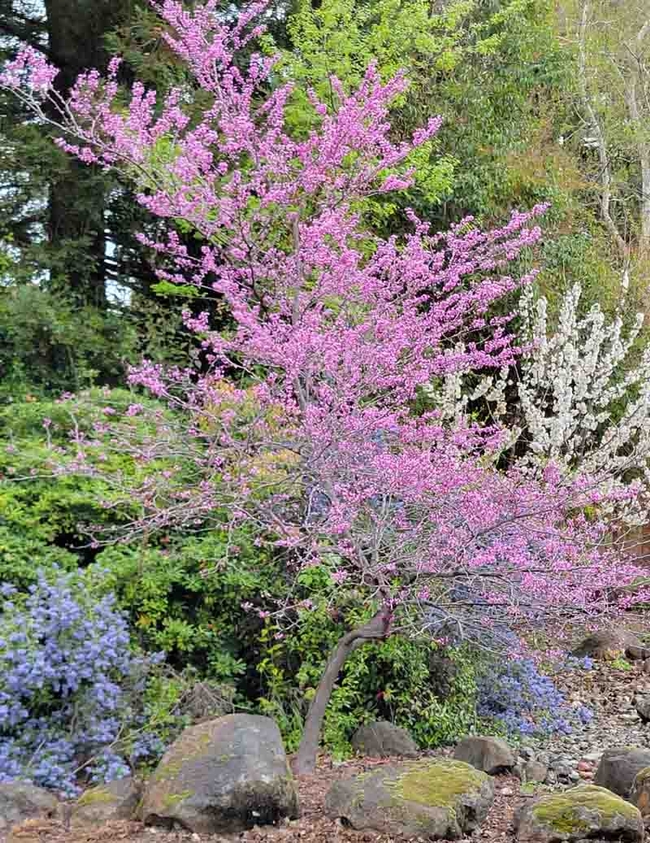
Cercis occidentalis is native to the arid western states. It is commonly known asWestern or California redbud, and sometimes Arizona redbud. Occidentem is Latin for “western sky” or “part of the sky in which the sun sets,” derived from the Latin verb occido – “go down, set.” The Occident is the longitudinal opposite of the Orient, and many species from China and other eastern regions are termed orientalis. Somewhere along the line, C. occidentalis acquired the second or synonymous binomial C. orbiculatum. Orbiculate translates naturally enough as round or circular in shape (in this case, in reference to the redbud's leaves). And if you are thinking now of Judas Tree as a common name, that belongs to the Eastern redbud. (Interestingly, the Latin name of the Eastern redbud is C. canadensis. And yes, you guessed it: canadensis is used in taxonomy to denote species indigenous to or strongly associated with Canada).
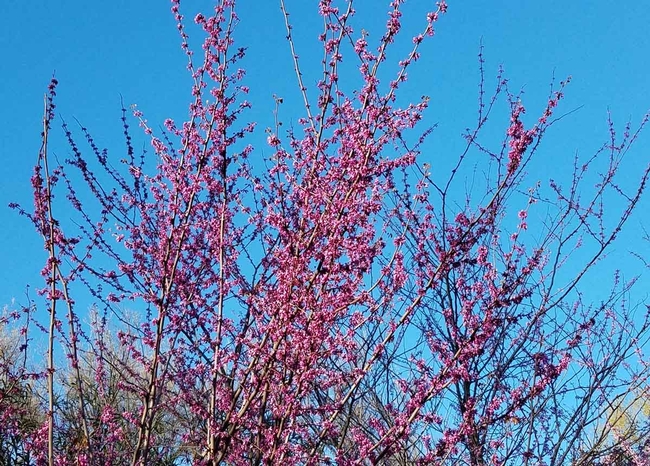
A hardy plant, the redbud is drought tolerant, sun-loving, and successful in a variety of soils. Typically, it prefers rather harsh environments with marginal, well-drained soils. It grows best in chaparral ecosystems below 4,000 feet in elevation, and prefers canyon walls and other steep slopes. It can also be found in gravely and rocky soils along streams above their flood zone. Western redbud tolerates some seasonal water and will grow in the bottom of ephemeral streambeds in little pockets, as well as on foothill benches, or tucked into crannies created by boulder outcroppings.
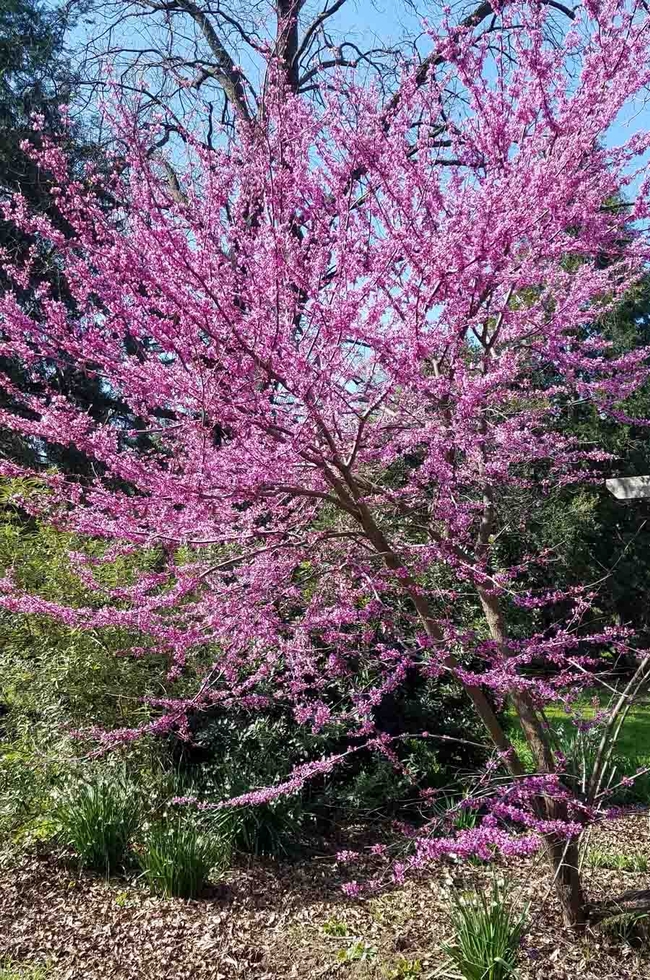
Western redbud is a popular landscape tree on the valley floor precisely because of its impressive beauty, which isn't restricted to eye-catching floral displays. The rounded, heart-shaped leaves are a silky combination of copper and green when they first emerge, darkening to various shades of green, gray-green, or blue-green. According to the USDA, the Western redbud's “autumn display of yellow turning to red and brown rival that of some eastern hardwoods.” This plant sets its fruit in the form of thin dry seed pods in autumn. Each pod contains about seven hard, bean-like seeds. As they ripen, the pods change in color from purple to russet brown. (On some redbuds, the mature pods hang on the branches into the next winter.) Once the redbud has shed itself of leaves and pods, the bare branches provide winter beauty as a silver-gray silhouette.
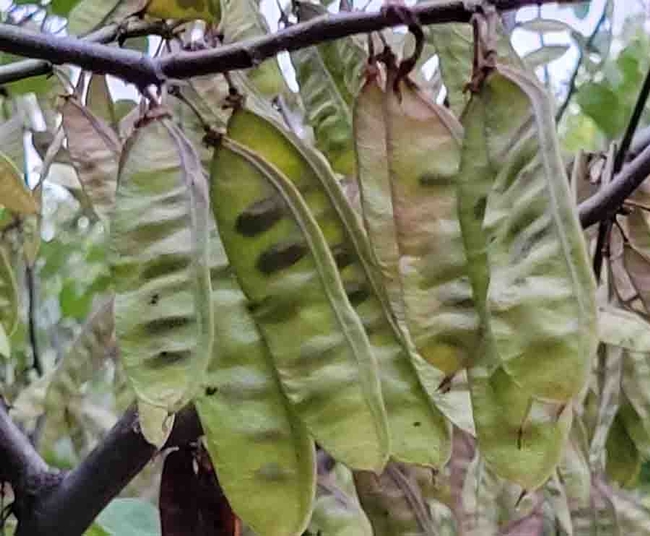
As a legume, redbud is an edible native. Native Americans enjoyed redbud flowers, young seed pods, and even young leaves, both raw and cooked. Apparently, redbud flowers taste almost as good as they look. Fully-opened flowers are somewhat tart and slightly sweet, and add interesting color and flavor (and Vitamin C!) to salads.
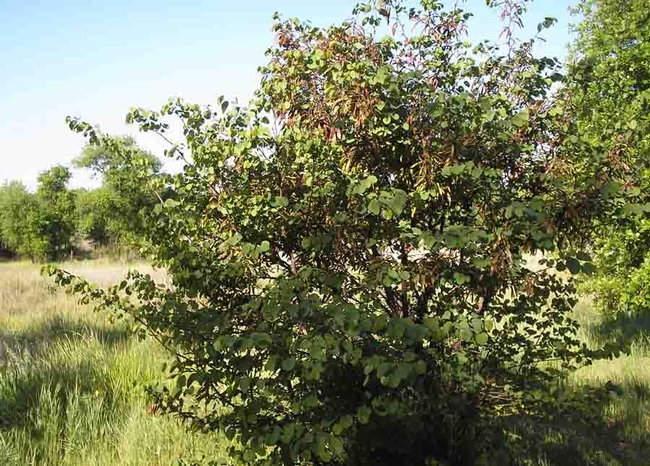
This beautiful and hardy native shrub is nowhere near as dull and plodding as its common name implies. While the redbud makes year-round contributions to the landscape, the Arbor Day Foundation correctly notes that “the sheer springtime beauty of the redbud may be its greatest hold on the American spirit.”
UC Master Gardeners of Butte County are part of the University of California Cooperative Extension (UCCE) system. To learn more about us and our upcoming events, and for help with gardening in our area visit our website. If you have a gardening question or problem, email the Hotline at mgbutte@ucanr.edu or leave a phone message on our Hotline at 530-552-5812. To speak to a Master Gardener about a gardening issue, or to drop by the MG office during Hotline hours, see the most current information on our Ask Us section of our website.
Ideally, you'd be reading this in very early spring, when the dogwood bloom is beginning to work its elegant magic in the older neighborhoods fanning out from Lower Bidwell Park and downtown Chico. Their flowers bloom before dogwoods leaf out, so the blooms appear to float, suspended on slender, graceful branches. But now, although their bloom time is over for the year, the new foliage on dogwoods makes them attractive landscape trees, creating filtered shade in gardens and yards across town.

General Characteristics: Dogwood trees are on the small side, ranging between 15 to 40 or so feet high. Typically, trunks are one foot or less in diameter, and often sport multiple stems. They provide four full seasons of delight: spring flowers, summer leaves, fall color and berries, and once all of those have dropped off in winter, the trunk displays a distinctive patterned bark and a pleasing rounded form with horizontal branching.
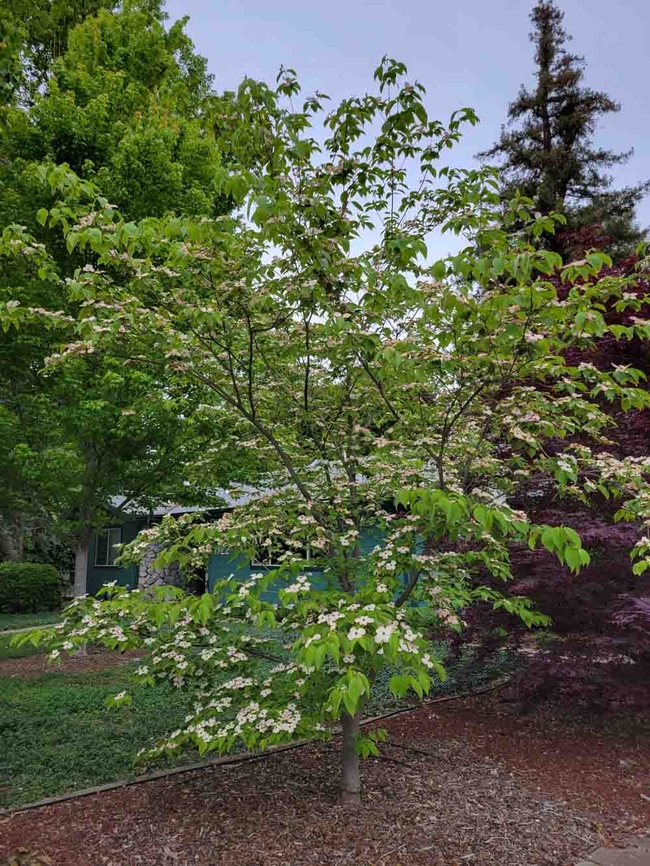
Cornus florida: The flowering dogwood is a popular landscape tree throughout the United States, and is commonly seen here in Chico and our surrounding area. The species name florida or florido is Spanish for “full of flowers” or “flowery”. Native to the Eastern US and northern Mexico, flowering dogwood attains its greatest size, up to 40 feet tall, in the Upper South where hot, humid summers contribute to new, lush growth. In other climates, such as ours, heights of 30–33 feet are more typical. This dogwood species' life span tops out at about 80 years. While its berries, ranging from bright red to yellow with a rosy blush, taste awful to humans, they are not toxic, and are an important source of food for many birds.
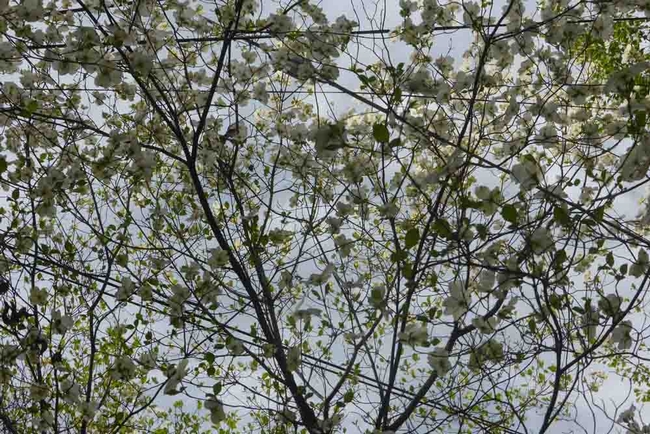
Cornus nuttallii: The species name of the Pacific dogwood honors Thomas Nuttall, an English botanist and zoologist who lived and worked in America from 1808 to 1841. Nuttall travelled widely and published a number of books on North American plants and birds. Almost 100 plant and animal species bear his name.
Nuttall's namesake dogwood species is commonly known as western dogwood, mountain dogwood, and Pacific mountain dogwood, as well as Pacific dogwood. This species is native to a large swath of western North America, sweeping down the continent from southern British Columbia to southern California, with an isolated population cropping up in central Idaho. On a California map, its distribution pattern looks like a large cane. The short, hooked end starts in the coast range north of the San Francisco Bay, thickening as it bends east through the Klamath and Siskiyou mountains, with the straight side of the cane extending south through the western slopes of the Cascades and Sierra Nevada mountains to the southern end of the great Central Valley. A small distribution also occurs in the southwestern corner of the state.
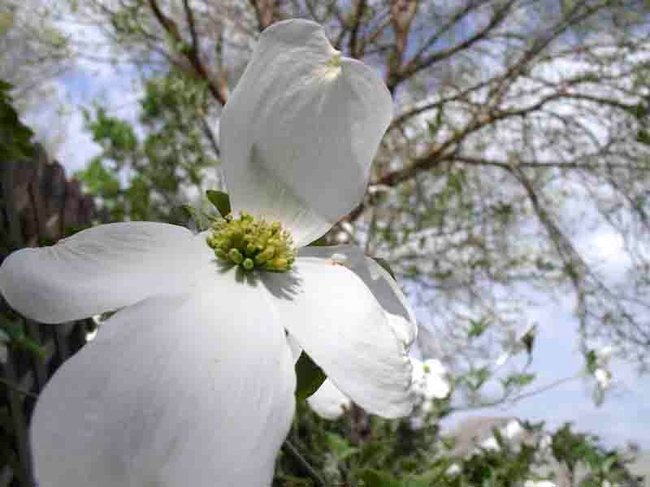
Besides its timeless aesthetic appeal, the Pacific dogwood has various utilitarian functions. It was an important plant for the Native tribes of the continent's west coast. Medicinally, the bark was used as a laxative, a tonic, an antiseptic, and for relief of stomach pain. Peeled twigs provided natural toothbrushes, and smaller branches were sometimes used in baskets. Today the wood of the Pacific dogwood is often used for fashioning items such as tool handles and cutting boards because of its hard, strong wood and beautiful tight grain. It has also been used to make thread spindles, golf club heads, and piano keys.
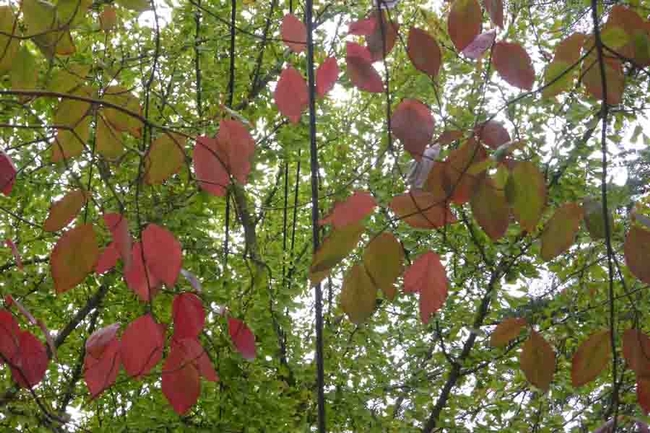
I love the ethereal beauty of the dogwood. Since a large number of cultivated dogwood trees grace our area, evidently so do many others. In fact, dogwood was among the top choices for America's National Tree in a nationwide survey hosted by the Arbor Day Foundation, coming in third behind the oak and redwood: a very respectable ranking!
UC Master Gardeners of Butte County are part of the University of California Cooperative Extension (UCCE) system. To learn more about us and our upcoming events, and for help with gardening in our area visit our website. If you have a gardening question or problem, email the Hotline at mgbutte@ucanr.edu or leave a phone message on our Hotline at 530-552-5812. To speak to a Master Gardener about a gardening issue, or to drop by the MG office during Hotline hours, see the most current information on our Ask Us section of our website.


